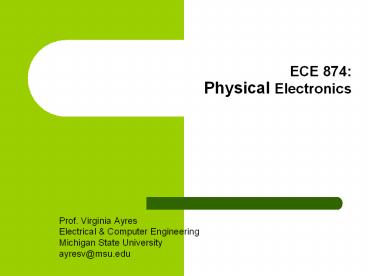ECE 874: Physical Electronics PowerPoint PPT Presentation
Title: ECE 874: Physical Electronics
1
ECE 874Physical Electronics
- Prof. Virginia Ayres
- Electrical Computer Engineering
- Michigan State University
- ayresv_at_msu.edu
2
Lecture 24, 20 Nov 12Chp. 05
Recombination-Generation Processes
3
Recombination-Generation ProcessesThese two
mechanisms are important at 300K and higher
temperatures
Absorption and Spontaneous emission Direct
bandgap materials like GaAs important
Recombination-generation (R-G) of electrons
and/or holes via a trap (a local
defect). Indirect bandgap materials like Si
very important. Will show that this process is
most efficient for traps near the mid-gap
Chp. 05 concentrates on (b)
4
(No Transcript)
5
(No Transcript)
6
Recombination-Generation Processes These two
mechanisms are important at low temperatures
Donor or acceptor sites act as local impurity
traps but are not near the mid-gap. Inefficient
version of R-G mechanism.
Exciton formation creates a non-dopant type of
bandgap state typically close to Ec or Ev. When
excitons form, they alter the n, p headcount.
When they annihilate they can produce photons
with close to the bandgap energy/wavelength.
This adds extra photons but also a spread to
emitted wavelengths. Important for direct
bandgap optoelectonic materials like GaAs at low
temps.
7
Recombination-Generation Processes this
mechanism is important at high n or p
concentrations
Auger process band-to-band recombination or
trap recombination is going on when a collision
with an outside n or p also occurs. The orginal n
or p gets and subsequently loses a lot of extra
energy. This is important for direct bandgap
materials like GaAs when what you want is
recombination that gives you bandgap
energy/wavelength photon emission and what you
get instead is a lot of thermal energy waste.
8
Recombination-generation (R-G) via a trap (a
local defect) why this is important
Rate for this steady state happening is
proportional to the trap density NT
dn/dt or dp/dt
J R width
9
pn junction in Si at equilibrium ( no bias)
Recombination-generation (R-G) via a trap (a
local defect) why this is important
- - - -
p p 1019 cm-3
n 1015 cm-3
Si
W
10
Same pn junction in Si in reverse bias - 5V
- Vrev
- - - -
- - - -
- - - -
- - - -
p 1019 cm-3
n 1015 cm-3
Si
W
Reverse bias goal turn the device OFF no
current flowing.
11
Diode equation Given tp stay-alive time for
holes on the n-side 10-6 sec
12
This seems to be a good solid OFF.
13
Find the depletion width WD too
14
(No Transcript)
15
In the Depletion region n, p and np are small
J R width time
-
Given tg generation time for holes on the
n-side same 10-6 sec
16
You didnt turn your device OFF as well as you
thought you did by four orders of magnitude.
17
What happened trap-mediated recombination-generat
ion (R-G) processes act to restore what ever the
previous steady state was.
In this example in the old steady state, the
n-side was largely a neutral region with
Now the same place is a depletion region WD with
Result Jgen traps released carriers in WD new
steady state
18
Example problem conditions steady state
19
General info
20
General info
Processes the change the e- headcount
Processes the change the hole headcount
21
Each one of these processes happens with better
or worse efficiencies
Hole capture
Hole emission
22
General info
Processes the change the e- headcount
Processes the change the hole headcount
23
Equilibrium
0 0
Under equilibrium conditions you can solve for
the emission coefficients in terms of the capture
coefficients (p. 145). Then, assuming that even
away from equilibrium, the capture coefficient
values dont change too much
OK cn, cp, n, p, nT, pT
Need n1, p1 (p. 145)
24
4.68 in the skipped Chp. 04 section on
ionization of dopants as a function of
temperature, and also traps as a function of
temperature.
25
(No Transcript)
26
Example problem calculate n1 for O in Si at 300K
for the closest to mid-gap trap.
27
Oxygen traps .16 eV below EC .38 eV below
EC .51 eV below EC
Oxygen traps .41 eV above EV
28
Oxygen trap nearest mid-gap is .51 eV below EC
EC ET .51 eV Where is it relative to
Ei? EC Ei .56 eV - .0073 eV 0.5527 EV
29
ET versus E T. Whats the difference? ET
includes the temperature dependence of the
trap.Equation 4.69 in the skipped Chp. 04
section on ionization of traps as a function of
temperature
1 or 2 is typical
ET is what you experimentally measure so the .51
eV below EC level on the graph is ET in our
problem.

